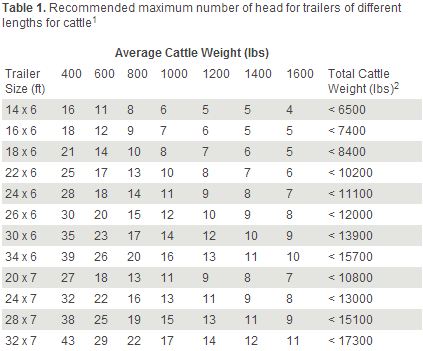



Do's and Dont's For Hauling Cattle Safely
Stocking rates for cattle trucks and guidance on how to move animals is given by South Dakota livestock stewardship expert Heidi Carroll.
The stocking density in trailers is important to maintain cattle well-being and minimize injuries. Table 1 has loading recommendations for various weights of cattle and various trailer sizes.
The Gross Vehicle Ratings should not be exceeded for trucks and trailers to ensure safe hauling. The maximum legal load limit must be followed for each state that cattle are being transported through. Additional loading recommendations for cattle pots can be found in the National Beef Quality Assurance Master Cattle Transporter Guide.
Cattle well-being should be maintained during the entire process of transporting cattle, from gathering and loading the animals to unloading. Calm, quiet low-stress handling methods should be used by everyone assisting.
Sorting sticks, flags, or paddles can be used to safely sort animals and humanely encourage movement. Electric prods should only be used on stubborn animals and then put out of reach after the animal cooperates. Evaluate the facilities and trailer for distractions if cattle continually balk and refuse to flow easily instead of resorting to excessive electric prod use.

A shadow, ground surface color change or a sweatshirt placed on a fence may inhibit cattle movement. Determine the appropriate weight distribution of cattle for your specific trailer type (gooseneck versus bumper hitch) and the number of compartments within the trailer.
When hauling cow/calf pairs, separate the cows from the calves in the trailer to ensure the safety of the calves.
When hauling bulls, separate bulls from each other and separate bulls from cows or calves. Bulls unfamiliar with each other should not be mixed on a trailer because damage to the trailer and animals is likely to occur if or when they fight to establish a hierarchy.
Horned or tipped cattle should be separated from polled, and space allowance should be appropriate for each group with respect to horn status.
Balance the weight to get the best towing performance and smoothest ride. Also be considerate of the route taken and how you drive to prevent cattle from jostling or slipping.
Avoid sudden accelerations, stops, or turns and pick roads that have minimal sharp turns or stops. Preparation, attention to detail, and low-stress handling ensures a safe, successful experience when hauling cattle this season. Safe transportation of cattle starts with proper maintenance of the truck/pickup and trailer.
During the busy spring season, maintenance and repairs may get pushed down the list of priorities. However, taking the time for maintenance checks will help things run smoother and safer when you begin hauling cattle.
Maintenance Should Include
- Inflating tires to the proper air pressure - including spare tires; replace worn or damaged tires
- Checking all lights, turn signals, brakes, electrical hookups, and vehicle fluid levels
- Greasing hitches and wheel bearings - if required; safety chains, gates and latches are functional and secure
- Trailer ventilation or protection are appropriate for current and future weather conditions if travelling long distances
- Checking flooring and ramps are safe and have appropriate traction to prevent slips or falls
- Cleaning and disinfecting the trailer to prevent transmitting pathogens between cattle and locations; remove all manure and old bedding
- Cleaning tires and undercarriage of truck if high risk of disease transmission
- Have a safety triangle/cone, tire iron and jack capable of lifting a loaded trailer in case of a flat tire
Performing maintenance checks a few days before cattle are scheduled to be hauled provides time to fix any problems without pushing back the transport date. Maintenance will minimize the risk of devastating accidents that can damage not only the equipment, but also injure or kill livestock.
Hauling cattle to summer pasture is a satisfying task after such a long, cold winter. Take the time to check over trucks and trailers to ensure it goes safe and smooth. Review humane handling methods with family members or employees to minimize the stress on the cattle and prevent injuries.



